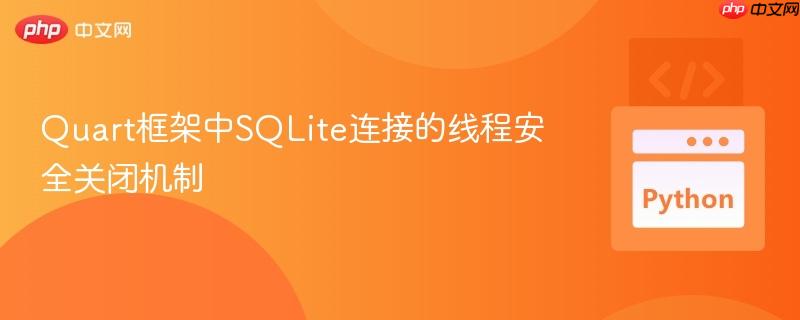
本文探讨了在quart框架中使用`teardown_appcontext`关闭sqlite数据库连接时遇到的线程错误,即`sqlite3.programmingerror: sqlite objects created in a thread can only be used in that same thread`。通过分析quart的执行机制和sqlite的线程限制,文章指出将同步的`close_db`函数改为异步协程是解决此问题的关键,确保数据库连接在创建线程中被正确关闭,从而避免并发错误。
在构建基于Quart的Web应用时,数据库连接的管理是核心任务之一。特别是对于像SQLite这样对线程有严格限制的数据库,正确地在应用上下文(app context)生命周期结束时关闭连接至关重要。本文将深入探讨在使用app.teardown_appcontext注册SQLite连接关闭函数时可能遇到的线程安全问题,并提供一个可靠的解决方案。
SQLite数据库连接是严格线程绑定的。这意味着一个sqlite3.Connection对象只能在其被创建的线程中使用。如果尝试在不同的线程中访问或关闭该连接,将会抛出sqlite3.ProgrammingError: SQLite objects created in a thread can only be used in that same thread。
Quart作为一个异步Web框架,其内部可能通过线程池来执行一些同步操作,例如通过loop.run_in_executor将同步函数调度到单独的线程中运行。当我们将一个同步函数注册到app.teardown_appcontext时,Quart在执行这个清理函数时,可能会将其调度到一个与创建数据库连接的线程不同的工作线程中,从而触发上述SQLite的线程绑定错误。
考虑以下典型的Quart应用上下文中的SQLite数据库连接管理代码:
#!/usr/bin/env python
# -*- coding: utf-8 -*-
from sqlite3 import connect, PARSE_DECLTYPES, Row
from click import command, echo
from quart import current_app, g
from quart.cli import with_appcontext
def get_db():
"""
连接到应用程序配置的数据库。
每个请求的连接是唯一的,如果再次调用则会重用。
"""
if not hasattr(g, "db"):
g.db = connect(
current_app.config["DATABASE"],
detect_types=PARSE_DECLTYPES,
)
g.db.row_factory = Row
return g.db
def close_db(exception=None):
"""
关闭数据库连接。
"""
db = g.pop("db", None)
if db is not None:
db.close()
@command("init-db")
@with_appcontext
def init_db_command() -> None:
"""
初始化数据库命令。
"""
db = get_db()
with open(current_app.root_path + "/schema.sql") as file:
db.executescript(file.read())
echo("Initialized the database.")
def init_app(app) -> None:
"""
注册数据库函数到Quart应用。
"""
app.teardown_appcontext(close_db) # 问题所在:注册了一个同步函数
app.cli.add_command(init_db_command)
return app当执行如quart init-db这样的CLI命令时,它会进入一个应用上下文,调用get_db创建连接,并在上下文结束时尝试调用close_db。如果close_db被调度到不同的线程,就会出现以下错误:
sqlite3.ProgrammingError: SQLite objects created in a thread can only be used in that same thread. The object was created in thread id 140328473665600 and this is thread id 140328443631296.
错误信息明确指出,数据库对象在线程A中创建,却在线程B中被访问。
Quart的teardown_appcontext设计上是支持协程(coroutine)的。当注册的清理函数是一个协程时,Quart会将其调度到主事件循环所在的线程中执行,这与创建数据库连接的线程是同一个。因此,将close_db函数改为异步函数即可解决此问题。
async def close_db(exception=None):
"""
异步关闭数据库连接。
"""
db = g.pop("db", None)
if db is not None:
db.close()通过将close_db函数定义为async def,Quart在执行teardown_appcontext时,会确保这个协程在主事件循环中运行,从而避免了跨线程访问SQLite连接的问题。
以下是修正后的db.py模块,其中close_db函数已改为异步协程:
#!/usr/bin/env python
# -*- coding: utf-8 -*-
from sqlite3 import connect, PARSE_DECLTYPES, Row
from click import command, echo
from quart import current_app, g
from quart.cli import with_appcontext
def get_db():
"""
连接到应用程序配置的数据库。
每个请求的连接是唯一的,如果再次调用则会重用。
"""
if not hasattr(g, "db"):
g.db = connect(
current_app.config["DATABASE"],
detect_types=PARSE_DECLTYPES,
)
g.db.row_factory = Row
return g.db
async def close_db(exception=None): # 关键修改:改为异步函数
"""
异步关闭数据库连接。
"""
db = g.pop("db", None)
if db is not None:
db.close()
@command("init-db")
@with_appcontext
def init_db_command() -> None:
"""
初始化数据库命令。
"""
db = get_db()
with open(current_app.root_path + "/schema.sql") as file:
db.executescript(file.read())
echo("Initialized the database.")
def init_app(app) -> None:
"""
注册数据库函数到Quart应用。
"""
app.teardown_appcontext(close_db) # 注册异步函数
app.cli.add_command(init_db_command)
return app在Quart框架中管理SQLite数据库连接时,由于SQLite的线程绑定特性与Quart的异步执行机制,将同步的数据库关闭函数注册到app.teardown_appcontext可能会导致sqlite3.ProgrammingError。通过将close_db函数改造为异步协程,Quart能够确保该清理操作在主事件循环线程中执行,从而遵守SQLite的线程限制,有效地解决了这一问题。理解并遵循异步编程的最佳实践,是构建健壮、高效Quart应用的关键。
以上就是Quart框架中SQLite连接的线程安全关闭机制的详细内容,更多请关注php中文网其它相关文章!

每个人都需要一台速度更快、更稳定的 PC。随着时间的推移,垃圾文件、旧注册表数据和不必要的后台进程会占用资源并降低性能。幸运的是,许多工具可以让 Windows 保持平稳运行。

Copyright 2014-2025 https://www.php.cn/ All Rights Reserved | php.cn | 湘ICP备2023035733号